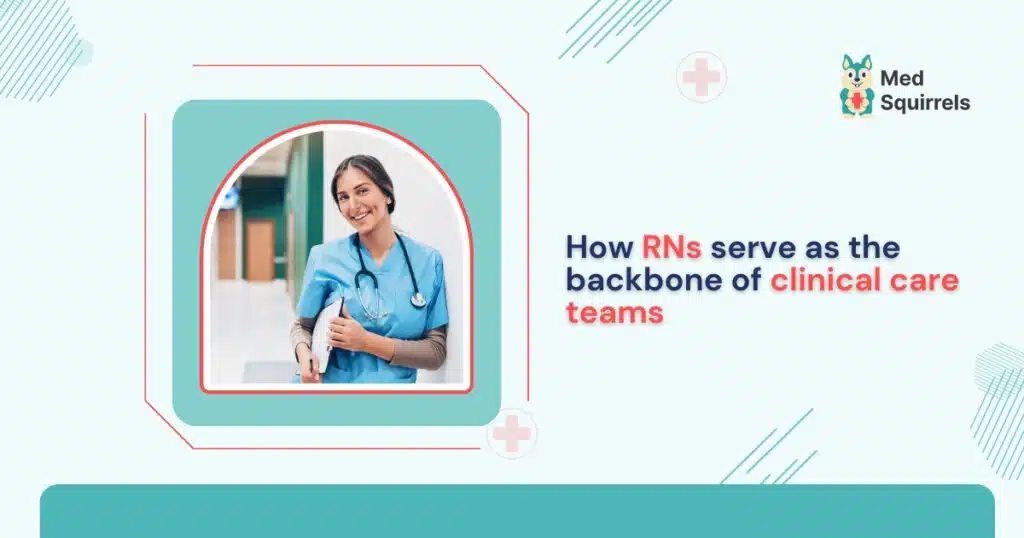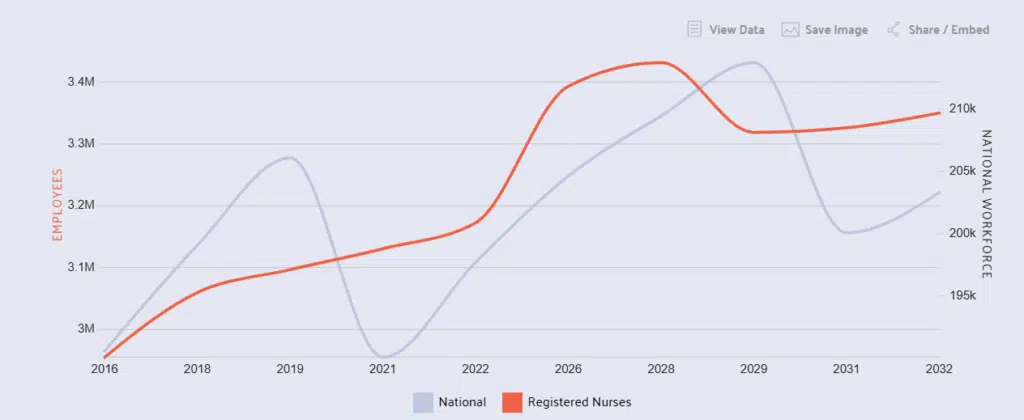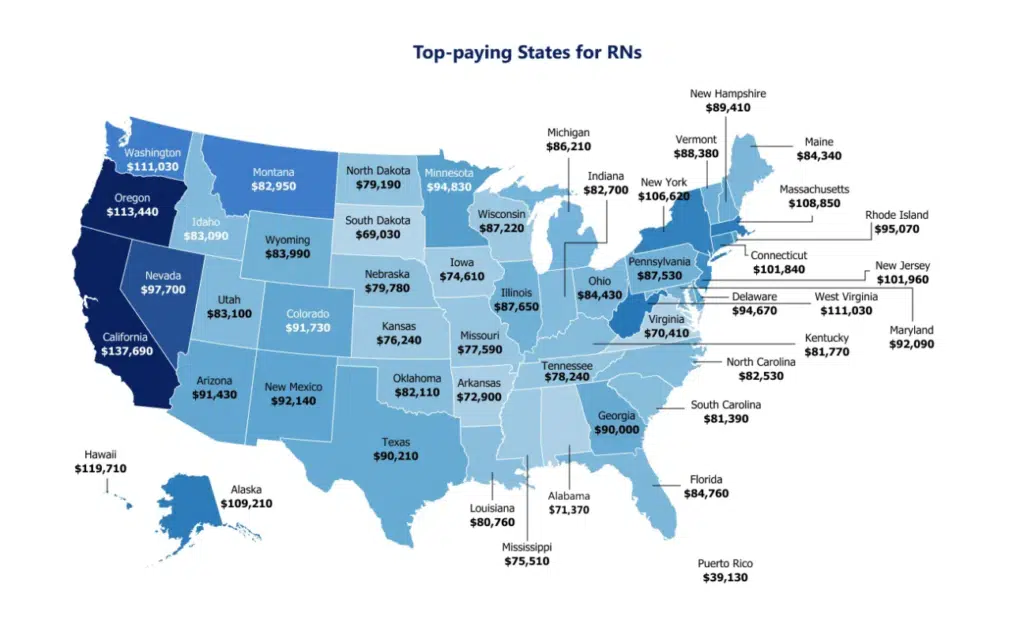How RNs serve as the backbone of clinical care teams

RNs are the backbone of healthcare teams, not only by providing essential patient care but also by extending leadership, collaboration, and patient advocacy. Registered nurses are the frontline of patient care professionals who assess the patient’s condition, administer medications, collaborate with physicians and other allied staff, supervise LVNs/LPNs and nurse assistants, educate patients and their families on disease management, and provide emotional support to patients suffering from chronic illness. Hence, there is an increased demand for registered nurses, and it is expected to rise by 6% in the upcoming decade, as per the data from the US Bureau of Labor Statistics Most often, registered nurses work in specialized environments, where their titles and duties depend on their settings and the specialized care they provide. Some of the most in-demand registered nurses are hired for the following roles:
- Oncology nurses: These RNs work with patients with cancer and optimize treatment for various stages of cancer.
- Geriatric nurses: They work alongside elderly patients to treat age-related health diseases in the geriatric population.
- Pediatric nurses: Children from birth to adolescent stage are the patient population with whom the pediatric nurses work.
- Travel nurse: These are registered nurses traveling from one healthcare facility to another based on staffing needs. They are especially useful in filling short-term nurse gaps.
- Acute care nurse: Acute care nurses are RNs working in the emergency units to provide immediate care to patients suffering from severe or life-threatening issues.
- Public health nurses: These are registered nurses working in specific communities and underserved areas to educate the population group on preventive care and safety issues.
- Patient advocate: These RNs work to address the concerns of patients and protect their rights.
Projected demand for registered nurses by 2032

Source:https://datausa.io/profile/soc/registered-nurses
The role of registered nurses (RNs) in leadership
To ensure optimal patient care delivery and patient satisfaction in healthcare, registered nurses lead the nursing team while also fostering collaboration between physicians and other allied health professionals. This collaborative care model ensures that the patient receives the best treatment. Moreover, while hiring newly graduated registered nurses, LPNs, or nurse assistants to the team, registered nurses provide mentorship to equip them to provide quality care under various emergency situations. With the clinical expertise of the registered nurses, they make informed decisions based on the clinical requirements and insights into staff scheduling. Considering the patient volume, the criticality of the care required, and the facility conditions, RNs help plan the workforce effectively to maintain the ideal nurse-to-patient ratio for better patient outcomes. This not only helps provide efficient patient care but also enhances staff retention by reducing staff burnout from intense workloads. Apart from managing workloads and teams, the healthcare leadership role comes with the essentiality of fostering a supportive and positive work environment. By understanding the downfalls in the nursing team, the RNs can help healthcare facilities devise plans to support employee well-being and professional development.
The impact of RNs on patient outcomes
Registered nurses can be patient advocates for supporting patient-centered care by educating them on their health condition and treatment options. With their clinical judgment and expertise, registered nurses detect any complications, such as cardiac abnormalities, infections, etc, by closely monitoring the vital signs of the patient. This aids in providing preventive care to the patients, which enhances the chance of faster recovery and reduces hospital readmissions. Also, registered nurses educate the patients on their medical condition, administering medications, best infection control practices, etc, so that medical errors such as adverse drug reactions can be prevented to a greater extent.
While also exhibiting clinical support to patients, registered nurses also provide emotional support by listening to their concerns and reassuring them to regain a healthy life. This can help boost the patient’s confidence and positive thinking, which can significantly enhance the patient’s recovery. For patients struggling with chronic health conditions, there is a higher risk of mental health concerns due to various factors. By building a healthy bond with the patients, registered nurses might be the first to identify it and address it by referring them to the concerned resources.
Future of nursing and the evolving role of RNs
The demand for registered nurses is increasing, and healthcare facilities are struggling to hire RNs who are skilled enough to work in various specializations. According to the US Bureau of Labor Statistics 194,500 openings are projected each year for registered nurses across the next decade. Even though there are 5.2 million registered nurses in the USA, as per the nurse statistics the demand to hire RNs will continue to increase due to various factors such as the aging population, retiring workforce, and increased awareness among people for preventive care.
It is equally important to note that the future of nursing trends holds significant technological advancements and the integration of technology in healthcare to ease the challenges in the nursing industry. The healthcare industry is now witnessing a nursing trend in telehealth and telemedicine after the COVID-19 pandemic. Furthermore, many healthcare facilities have adopted electronic health records for patient data management, which has increased the need for registered nurses skilled in tech competencies like health informatics. With the support of technology in healthcare, the RN roles are expected to evolve to provide more holistic patient-centered care.
How much are registered nurses being paid across the States?
Registered nurses in the USA are paid an average annual salary of $86,070, as per the US Bureau of Labor Statistics with registered nurses working in government departments earning the highest, followed by RNs working in hospital settings. California, Hawaii, and Oregon are the states that pay the highest salary for registered nurses. The annual mean wage of registered nurses in Oregon is $ 113,440, as indicated by the
US Bureau of Labor Statistics There is a high demand for registered nurses in Oregon, and the State Employment Projections denote the demand for registered nurses in Oregon to rise by 11.6% in 2032. According to the Oregon State Board of Nursing registered nurses are required to complete a board-approved registered nursing program and pass the NCLEX-RN certification to become licensed to practice in the state.

Source:https://www.registerednursing.org/articles/50-nursing-statistics/
Contract vs permanent staffing: which model is best for you?
When you hire registered nurses for your healthcare facility, understanding the different staffing options and their cost effectiveness is important for organizational efficiency and performance improvement in healthcare. You can hire an RN via contract mode or permanent mode. Both these permanent and contract staffing have their pros and cons. Let’s simplify them:
Contract staffing to hire RNs:
Pros:
- Reduced administrative workload as the recruitment, onboarding, and payrolling will be managed by a healthcare staffing agency.
- Greater flexibility on staff schedules in response to the fluctuating patient volume.
- Cost effective in terms of long-term benefits provided to permanent employees.
- Ability to fill specialized roles in the facility with registered nurses having specialized skills as per the need.
Cons:
- Need for additional training requirements as per the laws and policies governing the particular healthcare facility.
- Contract registered nurse hiring for a shorter duration can limit the continuity of care.
- As contract staffing is done via staffing agencies, there is a high chance that they charge huge markup fees, eventually making you spend above your budget.
Permanent staffing to hire RNs:
Pros:
- Continuity of patient care can be ensured which helps in building long-term patient relationships.
- Permanent staff have an increased sense of belonging and cultural fit which helps them in team collaboration.
Cons:
- There may be a high administrative workload and time spent screening candidates, interviewing, and onboarding them.
- It is not a good option for immediate staff requirements.
- The cost-to-company will be high as the permanent registered nurses are eligible for additional perks and benefits based on market standards and as governed by state labor laws.
Another mode of staffing is to hire travel nurses, however, travel nurses are hired to meet the sudden staff demand and can be expensive compared to the other staffing models.
How MedSquirrels can help with both contract and permanent RN staffing
MedSquirrels is a healthcare staffing and payroll platform that can be your go-to place for RN staffing solutions. As discussed above, MedSquirrels helps healthcare facilities analyze their unique needs and helps with the best staffing model that fits them. Be it contract staffing or permanent RN staffing, MedSquirrels has got your back with our various plans. Unlike traditional staffing agencies, MedSquirrels doesn’t charge any huge markup fees. At MedSquirrels, we believe in transparency and offer you a flat-fee approach where you just have to pay a flat license fee along with the payroll cost of the registered nurses hired through us. This model allows you to hire top talent under your budget while ensuring your hired RNs get paid above industry standards.
With MedSquirrels’ most popular Orange plan, you can hire contract RNs and also stay stress-free as our platform will handle their onboarding, payroll, and benefits. If you have already sourced a candidate, and are looking for a healthcare payrolling solution, our Purple plan will fulfill all your requirements. To know more about MedSquirrels’ staffing and payroll platform and how it works, book a demo today.
FAQs
How is MedSquirrels different from other staffing agencies?
MedSquirrels is a healthcare staffing solutions platform leveraging technologies like AI and automation to streamline the entire healthcare staffing process. Moreover, MedSquirrels doesn’t charge huge markup fees or hidden bill rates like most traditional staffing agencies. There is only a flat license fee along with the payroll cost that you need to pay per hire at MedSquirrels.
Can MedSquirrels support contract RN hiring?
MedSquirrels does support contract RN hiring and has one of the most popular plans for contract hiring + payrolling (Orange plan) where all the contract staffing needs of your facility from candidate sourcing, resume screening, credentialing, compliance check, onboarding, and payrolling will be taken care of. MedSquirrels also has the purple plan for recruitment only option.
How can I rely on the recruitment process at MedSquirrels?
The entire stages of MedSquirrels’ recruitment process are transparent and are made available to the user via an interactive dashboard. Healthcare facilities can track the status of their recruitment process at any time from anywhere with just a single click.
How can healthcare facilities attract top RNs?
The top strategies to attract talented registered nurses to your healthcare facilities include providing competitive compensation based on market standards, offering career advancement opportunities, fostering a positive work culture, promoting work-life balance, offering flexible shifts, and providing additional perks and benefits.
Why is there a shortage of Registered Nurses in the USA?
The major cause of the shortage of registered nurses in the USA is the retiring workforce. Some RNs are taking voluntary retirement from their profession as well due to burnout issues. Heavy workloads and extended shift timings are greatly affecting the work-life balance of the employees, causing significant work pressure.
